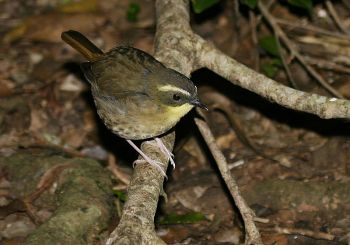(→External Links: Multiple GSearches combined) |
m (forgot to change category) |
||
| (2 intermediate revisions by 2 users not shown) | |||
| Line 1: | Line 1: | ||
| − | [[Image:Yellow- | + | [[Image:Yellow-throated Scrubwren (male) by Hans&Judy Beste (replacement).jpg|thumb|550px|right|Male<br />Photo © by '''[http://www.birdforum.net/member.php?u=49168 Hans&Judy Beste]'''<br />Toowoomba Shire, [[Queensland]], [[Australia]], 22 July 2018]] |
| − | ;[[:Category: | + | ;[[:Category:Neosericornis|Neosericornis]] citreogularis |
| + | ''Sericornis citreogularis'' | ||
==Identification== | ==Identification== | ||
| − | [[Image:Yellow-throated | + | [[Image:Yellow-throated Scrubwren (female) by Pearly_Shells (replacement).jpg|thumb|350px|right|Female<br />Photo © by {{user|Pearly_Shells|Pearly_Shells}}<br />[[Lamington NP]], [[Queensland]], [[Australia]], April 2006]] |
12–15 cm (4¾-6 in) | 12–15 cm (4¾-6 in) | ||
| + | |||
| + | '''Males:''' | ||
*Black facial mask and forehead | *Black facial mask and forehead | ||
*White and yellow [[Topography#Heads|supercilium]] | *White and yellow [[Topography#Heads|supercilium]] | ||
| Line 11: | Line 14: | ||
*White belly | *White belly | ||
*Olive flanks | *Olive flanks | ||
| − | *Dark greyish | + | *Dark greyish brown wings with yellowy outer edges |
| − | *Cream to pinkish | + | *Cream to pinkish grey legs |
| − | *Black bill | + | *Black bill |
| − | '''Females''': brown face mask and forehead<br /> | + | '''Females''': brown face mask and forehead |
| − | Young birds are duller than adults, with fawn underparts. | + | <br /> |
| + | '''Young birds''' are duller than adults, with fawn underparts. | ||
==Distribution== | ==Distribution== | ||
| Line 23: | Line 27: | ||
====Subspecies==== | ====Subspecies==== | ||
There are 3 subspecies<sup>[[#References|[1]]]</sup>: | There are 3 subspecies<sup>[[#References|[1]]]</sup>: | ||
| − | *'' | + | *''N. c. cairnsi'': |
| − | :*North | + | :*North-eastern [[Queensland]] (Cooktown to Paluma Range) |
| − | *'' | + | *''N. c. intermedius'': |
| − | :* | + | :*Eastern Australia (south-eastern Queensland to Clarence River, [[New South Wales]]) |
| − | *'' | + | *''N. c. citreogularis'': |
| − | : | + | :Eastern New South Wales (Clarence River to Mount Dromedary) |
==Habitat== | ==Habitat== | ||
| Line 34: | Line 38: | ||
==Behaviour== | ==Behaviour== | ||
| − | [[Image:BF Old Yellow-throated Scrubwren nest.jpg|thumb|350px|right|Old nest of subspecies ''intermedius''<br />Photo © by {{user|Delia+Todd|Delia Todd}}<br />[[ | + | [[Image:BF Old Yellow-throated Scrubwren nest.jpg|thumb|350px|right|Old nest of subspecies ''intermedius''<br />Photo © by {{user|Delia+Todd|Delia Todd}}<br />[[Lamington NP]], [[Queensland]], [[Australia]], 16 October 2019]] |
====Diet==== | ====Diet==== | ||
Their diet consists mostly of insects, worms and spiders, with the inclusion of seeds, fungus and fruit. | Their diet consists mostly of insects, worms and spiders, with the inclusion of seeds, fungus and fruit. | ||
====Breeding==== | ====Breeding==== | ||
| − | They build a long, bulky domed nest with a hooded side entrance, from roots, vine tendrils, leaf skeletons, moss and twigs, and lined with feathers. The clutch consists of 2-3 brownish | + | They build a long, bulky domed nest with a hooded side entrance, from roots, vine tendrils, leaf skeletons, moss and twigs, and lined with feathers. The clutch consists of 2-3 brownish purple to pale brownish white eggs with darker spots or blotches. |
==References== | ==References== | ||
| − | #{{Ref- | + | #{{Ref-Clements6thOct22}}#Avibase |
#Handbook of the Birds of the World Alive (retrieved November 2016) | #Handbook of the Birds of the World Alive (retrieved November 2016) | ||
#Birds in Backyards | #Birds in Backyards | ||
{{ref}} | {{ref}} | ||
==External Links== | ==External Links== | ||
| − | {{GSearch|"Sericornis citreogularis" {{!}} "Yellow-throated Scrubwren"}} | + | {{GSearch|"Sericornis citreogularis" {{!}} "Neosericornis citreogularis" {{!}} "Yellow-throated Scrubwren"}} |
{{GS-checked}} | {{GS-checked}} | ||
<br /> | <br /> | ||
<br /> | <br /> | ||
| − | [[Category:Birds]] [[Category: | + | [[Category:Birds]] [[Category:Neosericornis]] |
Latest revision as of 13:36, 15 January 2023
- Neosericornis citreogularis
Sericornis citreogularis
Identification
12–15 cm (4¾-6 in)
Males:
- Black facial mask and forehead
- White and yellow supercilium
- Bright yellow throat
- Dark olive brown crown and back
- White belly
- Olive flanks
- Dark greyish brown wings with yellowy outer edges
- Cream to pinkish grey legs
- Black bill
Females: brown face mask and forehead
Young birds are duller than adults, with fawn underparts.
Distribution
East coast of Australia: found in New South Wales, Queensland and Victoria
Taxonomy
Subspecies
There are 3 subspecies[1]:
- N. c. cairnsi:
- North-eastern Queensland (Cooktown to Paluma Range)
- N. c. intermedius:
- Eastern Australia (south-eastern Queensland to Clarence River, New South Wales)
- N. c. citreogularis:
- Eastern New South Wales (Clarence River to Mount Dromedary)
Habitat
Dark understorey of coastal rainforests and wet, timbered gullies with dense vegetation.
Behaviour

Photo © by Delia Todd
Lamington NP, Queensland, Australia, 16 October 2019
Diet
Their diet consists mostly of insects, worms and spiders, with the inclusion of seeds, fungus and fruit.
Breeding
They build a long, bulky domed nest with a hooded side entrance, from roots, vine tendrils, leaf skeletons, moss and twigs, and lined with feathers. The clutch consists of 2-3 brownish purple to pale brownish white eggs with darker spots or blotches.
References
- Clements, J. F., T. S. Schulenberg, M. J. Iliff, T. A. Fredericks, J. A. Gerbracht, D. Lepage, S. M. Billerman, B. L. Sullivan, and C. L. Wood. 2022. The eBird/Clements checklist of Birds of the World: v2022. Downloaded from https://www.birds.cornell.edu/clementschecklist/download/
- Avibase
- Handbook of the Birds of the World Alive (retrieved November 2016)
- Birds in Backyards
Recommended Citation
- BirdForum Opus contributors. (2024) Yellow-throated Scrubwren. In: BirdForum, the forum for wild birds and birding. Retrieved 18 May 2024 from https://www.birdforum.net/opus/Yellow-throated_Scrubwren
External Links
GSearch checked for 2020 platform.





